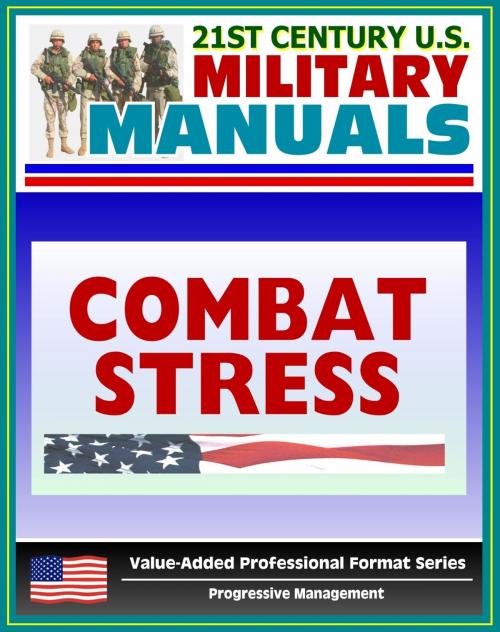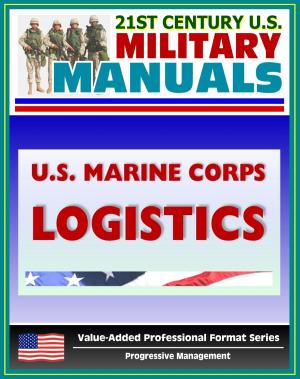21st Century U.S. Military Manuals: Combat Stress (FM 6-22.5) Sleep Deprivation, Suicide Prevention (Value-Added Professional Format Series)
Nonfiction, Health & Well Being, Psychology, Mental Illness| Author: | Progressive Management | ISBN: | 9781465759849 |
| Publisher: | Progressive Management | Publication: | September 7, 2011 |
| Imprint: | Smashwords Edition | Language: | English |
| Author: | Progressive Management |
| ISBN: | 9781465759849 |
| Publisher: | Progressive Management |
| Publication: | September 7, 2011 |
| Imprint: | Smashwords Edition |
| Language: | English |
Professionally converted for accurate flowing-text e-book format reproduction, the Combat Stress Field Manual (FM 6-22.5) provides the tactics, techniques, and procedures required for small-unit leaders to effectively prevent, identify, and manage combat stress when it occurs. This publication contains essential information about combat and combat-related stress. It describes, in layman's terms, techniques to prevent, identify, and treat harmful combat stress reactions at the lowest level or until professional medical assistance is available. It provides a basic understanding of the causes of stress and describes the preventive actions that can be taken to avoid or reduce its harmful effects. It describes how to identify and manage combat stress symptoms when they appear, and provides techniques to prepare units to handle combat stress reactions when they occur. All small-unit leaders should read this publication.
It states in the preface:
"Combat Stress is the mental, emotional or physical tension, strain, or distress resulting from exposure to combat and combat-related conditions. Controlling combat stress is a command responsibility. In terms of Service members lost from action and reduced performance, combat stress seriously affects mission accomplishment. It is a leader's responsibility to take action to strengthen Service members' tolerance to combat stress and manage it in his or her unit. Combat stress reactions are the result of exposure to the same conditions during military actions that cause physical injury and disease in battle or its immediate aftermath, and many combat stress reactions occur in persons who are also wounded or ill with disease. Rates of combat stress casualties vary greatly, with higher ratios during lengthy periods of intense combat. In Okinawa 1945, during a peak month of battle, the combat stress casualties among Marine Forces were reported as high as one for every two wounded in action (WIA). Under less lengthy periods, as suggested by data acquired from the Israeli Defense Forces fighting in Lebanon 1982, the ratio of combat stress casualties to WIA in small units can be as high as one to one. In the past, we have generally suffered as many as one battle stress casualty for every three to five WIA in heavy fighting. However, highly trained units with strong leadership and high esprit de corps have fewer combat stress casualties. While this manual focuses on combat-induced stress reactions, it is important to emphasize that "combat stress" is not restricted only to combat, but may also arise from combat-like conditions present during military operations other than war. In an area of operations characterized by continuous action and high danger, our forces may experience high rates of stress casualties unless small-unit leaders are trained and prepared to manage stress."
Some highlights of the contents:
Stress Control, Programs, Safety Considerations, Challenges of Sleep Deprivations, Achieving Sleep in Combat, Sleep Rest Planning, Suicide Awareness
As a bonus, this reproduction includes FM-1, The Army Field Manual, a capstone manual containing the vision for the Army - sold separately for $5.99. FM 1 establishes the fundamental principles for employing Landpower. The most important of these are the Army's operational concept and the fundamentals that support it. They form the foundation for all Army doctrine. All Soldiers should understand and internalize them. FM 1 describes the American profession of arms, the Army's place in it, and what it means to be a professional Soldier.
This is a privately authored news service and educational publication of Progressive Management.
Professionally converted for accurate flowing-text e-book format reproduction, the Combat Stress Field Manual (FM 6-22.5) provides the tactics, techniques, and procedures required for small-unit leaders to effectively prevent, identify, and manage combat stress when it occurs. This publication contains essential information about combat and combat-related stress. It describes, in layman's terms, techniques to prevent, identify, and treat harmful combat stress reactions at the lowest level or until professional medical assistance is available. It provides a basic understanding of the causes of stress and describes the preventive actions that can be taken to avoid or reduce its harmful effects. It describes how to identify and manage combat stress symptoms when they appear, and provides techniques to prepare units to handle combat stress reactions when they occur. All small-unit leaders should read this publication.
It states in the preface:
"Combat Stress is the mental, emotional or physical tension, strain, or distress resulting from exposure to combat and combat-related conditions. Controlling combat stress is a command responsibility. In terms of Service members lost from action and reduced performance, combat stress seriously affects mission accomplishment. It is a leader's responsibility to take action to strengthen Service members' tolerance to combat stress and manage it in his or her unit. Combat stress reactions are the result of exposure to the same conditions during military actions that cause physical injury and disease in battle or its immediate aftermath, and many combat stress reactions occur in persons who are also wounded or ill with disease. Rates of combat stress casualties vary greatly, with higher ratios during lengthy periods of intense combat. In Okinawa 1945, during a peak month of battle, the combat stress casualties among Marine Forces were reported as high as one for every two wounded in action (WIA). Under less lengthy periods, as suggested by data acquired from the Israeli Defense Forces fighting in Lebanon 1982, the ratio of combat stress casualties to WIA in small units can be as high as one to one. In the past, we have generally suffered as many as one battle stress casualty for every three to five WIA in heavy fighting. However, highly trained units with strong leadership and high esprit de corps have fewer combat stress casualties. While this manual focuses on combat-induced stress reactions, it is important to emphasize that "combat stress" is not restricted only to combat, but may also arise from combat-like conditions present during military operations other than war. In an area of operations characterized by continuous action and high danger, our forces may experience high rates of stress casualties unless small-unit leaders are trained and prepared to manage stress."
Some highlights of the contents:
Stress Control, Programs, Safety Considerations, Challenges of Sleep Deprivations, Achieving Sleep in Combat, Sleep Rest Planning, Suicide Awareness
As a bonus, this reproduction includes FM-1, The Army Field Manual, a capstone manual containing the vision for the Army - sold separately for $5.99. FM 1 establishes the fundamental principles for employing Landpower. The most important of these are the Army's operational concept and the fundamentals that support it. They form the foundation for all Army doctrine. All Soldiers should understand and internalize them. FM 1 describes the American profession of arms, the Army's place in it, and what it means to be a professional Soldier.
This is a privately authored news service and educational publication of Progressive Management.















